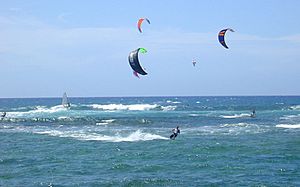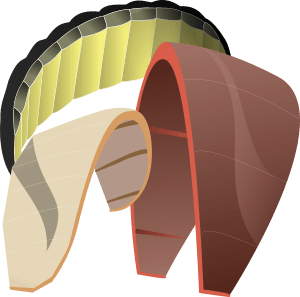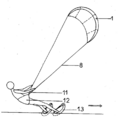Power kite facts for kids
A power kite is a special kind of large kite that's built to create a lot of pulling force. People use these powerful kites for exciting sports and activities! They can pull you across water, land, or even snow.
Contents
Types of Power Kites
There are two main types of power kites you'll often see:
- Foil kites
- Leading Edge Inflatable (LEI) kites
There are also other less common types, like kites with stiff frames or single-layer soft kites. All these kites use different control systems, usually with two to five lines and a bar or handles to steer them.
Foil Kites
Foil kites look a bit like a paraglider wing. They are made of many fabric cells, which are like small pockets. Inside these cells are cloth ribs that give the kite its special wing shape. This shape helps the kite catch the wind and create lift.
Most foil kites are "ram-air" foils. This means they have openings at the front that let air rush in when the kite is flying. This air fills the cells, making the kite stiff and helping it keep its shape. Some ram-air foils are "closed-cell." They have a special valve that traps air inside the cells. This design helps them float and be relaunched more easily if they land in water.
Leading Edge Inflatable (LEI) Kites
LEI kites are made from a single layer of fabric. As their name suggests, they have an inflatable tube along their front edge and inflatable ribs. Before you launch an LEI kite, you use a pump to fill these tubes with air. The inflated tubes give the kite its strong shape.
LEI kites are very popular for kitesurfing. This is because they keep their shape even when they get wet. If an LEI kite falls into the water, it's easy to relaunch it from the surface. Foil kites, especially open-celled ones, can get soaked and become too heavy to fly if they crash into the sea.
What Are Power Kites Used For?
Power kites are often used with a vehicle or a board to move you around. Here are some popular activities:
- Kitesurfing: Riding on a board across the water.
- Kite buggying: Driving a special three-wheeled cart.
- Kite landboarding: Riding an all-terrain board on land.
- Kite skating: Using special all-terrain roller skates.
- Kiteboating: Pulling a boat across the water.
- Snowkiting: Gliding on skis or a snowboard over snow.
People also use power kites just for fun, without a vehicle. This can include kite jumping, where the kite lifts you into the air!
Scientists are even looking into using large kites to generate electric power. These "laddermills" are like airborne wind turbines. They can reach very high altitude winds, like the jet stream, which are always blowing, even when there's no wind closer to the ground for regular wind turbines.
Kites are also used in sailing, especially for speed sailing. A kite-powered boat called Jacob's Ladder set a world sailing speed record in 1982, reaching about 46 kilometers per hour (25 knots). This record stood for six years! Later, in 2008, a kiteboard was the first sailing craft to go faster than 93 kilometers per hour (50 knots).
Power kites come in many sizes, from small ones (about 1.2 square meters) to very large ones (up to 50 square meters). Each size and design is made for a specific purpose, whether it's for water, land, or for more power or easier steering.
How Power Kites Work: Bridle Systems
The way a kite flies and how much pull it creates depends on its "angle of attack." This angle is set by the kite's "bridle." The bridle is a set of lines that connect the main control lines to many points across the kite's surface. Power kites with four or five lines come in two main types: fixed bridle and depowerable.
Fixed Bridle Kites
Fixed bridle kites have a set angle of attack that you can't change while the kite is flying. You might be able to make small adjustments to the bridle when the kite is on the ground.
If the angle of attack is set high, the kite will give you more power. But it might not fly as fast or as close to the wind. A low angle of attack means less power, but the kite will be faster and can fly closer to the edge of the wind "window." Fixed bridle kites can be used with handles or a bar. Handles are often preferred for things like kite jumping or kite buggying, while a bar is good for kite landboarding.
Depowerable Kites
Depowerable kites are used with a control bar and a harness system. The main power lines of the kite connect to your harness through a hole in the center of the bar. The bar can slide a few inches along these lines. This means you can pull the bar closer to you to increase the kite's angle of attack. This makes the kite create more lift and power, which is then transferred to your harness while you're flying.
Kites used for kitesurfing are almost always depowerable. Some modern kites, like bow kites, can reduce their power by almost 100%. This makes them much safer and more versatile.
Safety with Power Kites
Kite safety systems have become much better in recent years. Today, almost all four and five-line kites come with a safety system. These systems are designed to quickly remove power from the kite if you get too much pull or lose control.
When you fly a fixed bridle kite, you might use "kite killers." These are straps attached to your wrist(s) with bungee cords. If you let go of the handles or bar, these straps pull on the kite's brake lines. This makes the kite flap in the wind and lose its shape, so it no longer pulls you.
Depowerable kites have similar safety systems. Since these kites are usually attached to your harness, you use a special toggle or handle to activate the safety system. This releases the bar and power lines from your harness.
Some depowerable kites use a "5th line safety system." This fifth line isn't used during normal flying. But when the safety system is activated, all the usual four lines become loose. This makes the kite fold or roll backward, losing its shape and power. The kite stays attached to you by the 5th line, so you can get it back safely.
Images for kids
-
Peter Lynn lifting a kite in Dieppe, September 1988





